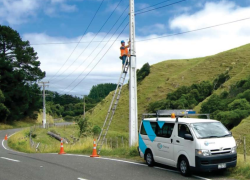Today’s widespread use of field service technicians and vehicles – coupled with the speed of technological innovation – calls for a transformational technology solution that changes the face of field services and the supply chain. Many types of enterprises depend on a field service force to set up, install, enable and maintain their products, services and applications.
Almost any type of product or service that requires a reasonably complex setup and installation process on the customer’s premises will utilise a field service technician to perform the associated tasks.
To complete their work efficiently, technicians usually require a service vehicle, an inventory of parts, mechanical tools, measuring and testing devices, a laptop and a mobile device. Standard solutions often only address pieces of the problem in silos and these kinds of enablers do not necessarily address the problem of creating an efficient workday. Work orders are generally provided in paper form and ensuring that the right inventory and tools are in the vehicle is often a manual process involving a degree of guesswork. Further inefficiencies are likely because dispatchers are usually unaware of work order status, inventory usage, tool status, and so on, until a technician returns to the depot with reports and paperwork for the day or week. In addition, many equipment activation processes may require interaction with a central operations centre and/or demand that a technician contact a call centre and enter a queue to have someone activate a product or service to test it. The streamlined automation made possible by today’s technology is clearly absent.
A recent example of the application of the Nokia IMPACT horizontal platform for IoT into the field service segment was market trialled in New Zealand. This case study example had multiple standalone vertical applications that were integrated and centrally managed due to the capabilities of the IMPACT IoT platform. The horizontal integration of fleet management, customer premise equipment provisioning, inventory management, as well as technician video communications and training, enabled business value to be unlocked by greatly improving the productivity of the entire broadband installation process for Chorus, a New Zealand national broadband service provider. Beyond productivity improvements, there was an additional revenue opportunity identified by offering a new provisioning service for the communications service providers (CSPs) with direct customer contact.
 The solution
The solution
Figure 1 shows how the IMPACT IoT platform was deployed to solve the problem by integrating management of sensors and devices, workflow and inventory, enhanced communications, support for material delivery and management, and real-time visibility to system status by the key players within the value delivery chain. Such a solution could save time, reduce errors, minimise cost, increase collaboration, and provide better documentation while simultaneously improving the experience of the most important player in the chain – the end customer. Improving customer experience along the entire value chain and providing a positive return on investment (ROI) in the process makes such a solution an obvious choice to create and implement.
Business benefits
The value chain and players that perform the installation process may sometimes be complex. The more complex, the more important transparency and access to real-time status become. As an example, in the case of this market trial the network provider uses third-party installers. There are numerous relationships and much complexity built into the value chain that performs broadband installations under the Chorus brand. This has clear benefits in efficiency and time-to-market, but requires all players to have a common ability to share data and have real-time visibility of installation status — which can be provided by the IMPACT solution. In this case, the benefits flow to the entire chain, but even if the relationships were simpler, the concept still provides value because even within a single company these organisational boundaries and resulting challenges exist. Deployment of IMPACT with the visibility to data enabled greatly reduces complexity of the installation process.
Results summary
 • 30% to 40% of the warehouse manager’s time was saved via IMPACT inventory management application integration to enable inventory automation and tracking.
• 30% to 40% of the warehouse manager’s time was saved via IMPACT inventory management application integration to enable inventory automation and tracking.
• Errors and mistakes due to use of paper and manual inventory tracking were eliminated by automating workflow and integration with IMPACT.
• Total installation time was reduced by between one-third to one-half.
• US$77 dollars (NZ$102, €71) per update per vehicle can be avoided utilizing IMPACT device management to perform OTA vehicle and device updates.
• Training documentation was simpler to find and track.










